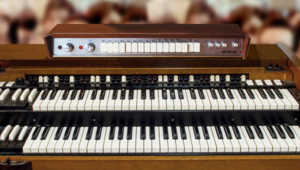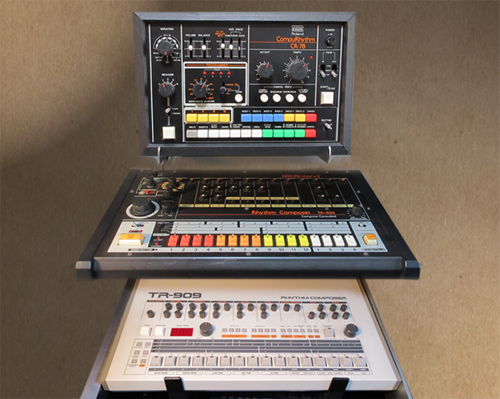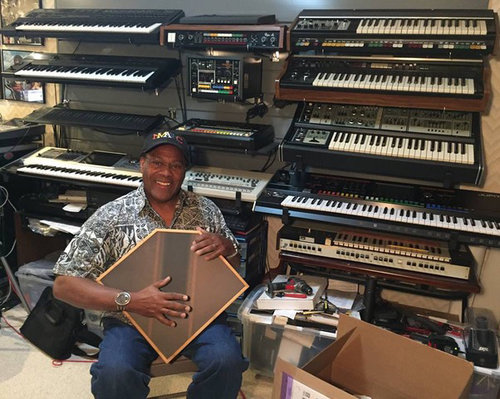TR-808 The Downbeat of Innovation
By Susan Hayes © All Rights Reserved
Percussion is the back beat, down beat, foundation for and expression of temperament in music. The evolution of Roland’s TR808 has been all that and more- its versatility inspiring new uses for the instrument, as well as a new genre of music.
Don Lewis’s involvement with the TR808 began with Ace Tone’s original version, the FR-2L, known as the iconic “Rhythm Ace,” which he first started using in the late 1960s to add electronic percussion accompaniment to his organ music.

Without external controls, Don would adjust circuitry manually for every new rhythm pattern for every song, sometimes adding parts and soldering them in place to achieve the sounds he desired.
It was one of those modified rhythm units that brought Don to the attention of Ikutaro Kakahashi, founder of Ace Tone and Roland music companies, at a Hammond Organ concert at the National Association of Music Merchants (“NAMM”) in 1969.
Following the performance, Don recalled “Mr. K” introducing himself, smiling and saying. “This looks like my rhythm unit, but it doesn’t sound like my rhythm unit.”
Don showed him his modifications, including how he wired the FR-2L through the Hammond organ to the expression pedal which controls volume so he could add accents- a feature the Rhythm Ace didn’t have.
They agreed there had to be a way to make these sound adjustments accessible and programmable for all musicians. That meeting of the minds would form the basis for a lifelong friendship and collaboration which endured for close to 50 years, until Mr. K’s death in 2017.
Consulting with Roland
 Throughout the 1970s, Don and Mr. K flew back and forth between San Francisco and Japan to work with Roland’s development teams, with Don providing user feedback to the engineers doing the technical work.
Throughout the 1970s, Don and Mr. K flew back and forth between San Francisco and Japan to work with Roland’s development teams, with Don providing user feedback to the engineers doing the technical work.
“I was honored they felt my contribution would add value to their products,” Don said of that time. “I felt like I was part of the musical world most musicians don’t have an opportunity to engage in, especially early on in the process.”
Though Mr. K and Don spent hours exchanging ideas and drawing schematics on napkins about rhythm units and other synthesizers, he was always humbled to meet the engineers who brought the ideas to life, such as Tadao Kikumoto. “It was always exciting to go to Japan and see the new prototypes in ‘breadboard form’ and brainstorm with the engineering team,” said Don. “They are the unsung heroes of the music industry.”
In 1978, Don was using a newer version, the FR-7L, when performing with the synthesizer system he built, LEO (Live Electronic Orchestra) at the Hungry Tiger in San Francisco. He was also consulting with Roland on the development of the CR-68 and CR-78, which had programmable rhythm, sequencing features and memory for storing patterns.
“I was playing a variety of pop, jazz, gospel and disco music so it was nice not to have to rewire the rhythm unit for each separate song style,” Don recalled.
Yet he still saw potential for improvement and created new programs for his own CR-78 for hand claps, while making suggestions to Roland’s technicians for the next generation of rhythm units, which turned out to be the TR-808.
“When the first TR-808 arrived on my doorstep from Japan, I couldn’t wait to start programming it. And when I added it to LEO everything changed- not just the drum tracks.”
Don began to use the unit not only as a complement to LEO and his other synthesizers, but also discovered how to use it to trigger and synchronize with other instruments.
“I used other signals from the TR-808 to trigger one of LEO’s synthesizer components, the Roland JP-4, creating comping chords and strumming effects,” Don explained. “By holding down the keys, it wouldn’t be one sustained sound, rather it would synchronize notes played.”
In 1983, Roland released the TR909, the first version to use samples. Don was producing commercial music in his studio at the time and found the TR-909 with MIDI added was well-suited to the digital studio sound of the newer versions of the MIDI keyboards he used there.
As commercial interest in the TR-808 began waning, interest in digital music started rising and the TR-909 took off in popularity. Soon thereafter, the TR-808 found a new audience and inspired a new genre of music as the soul of the hip hop culture in New York City.

And the Beat Goes On
“The 808’s electronically-generated sound was one that rap and hip-hop artists identified with: anti-establishment and more aggressive than regular percussive instruments,” said Don. “It had a tone and sound palate that in some cases showed there was a disturbance in the force of life.”
It also brought music to those who couldn’t afford it, for which he was glad. “I heard the price for a used TR808 was then around $100 dollars, making it accessible to musicians with few resources,” Don said. “Music was no longer being taught in the schools and we were in danger of losing an entire generation of music creators.”
Fortunately, that wasn’t the case and Don believes one key reason was the availability of electronic percussion instruments like the TR-808. With its current availability in software form, it is even more accessible to emerging and established musicians of all ages, in all musical genres.
This continuing evolution is gratifying to Don. “The ongoing use of the TR808 proves that even when you don’t have what everyone else has, it doesn’t stop you from creating.”
For more info: https://en.wikipedia.org/wiki/Don_Lewis_(musician)
Susan Hayes is a professional writer, editor and documentary film enthusiast based in Northern California. Her Sundance Film Festival record stands at 13 films in four days.